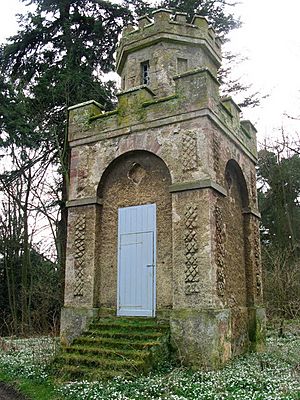Saltoun Hall facts for kids
Saltoun Hall is a historic and large house located in East Lothian, Scotland. It stands on a big piece of land near the B6355, about 1.5 miles from the villages of Pencaitland and East Saltoun. You reach the house through an impressive entrance.
The Story of Saltoun Hall
Saltoun Hall started as a tower or castle way back in the 1100s. At that time, a powerful family called the de Morvilles owned it. Hugh de Morville was given the land by King David I. His family became the "hereditary High Constables of Scotland." This was a very important job, like being a chief military officer for the king. Hugh de Morville was also known for helping religious places, like founding Dryburgh Abbey around 1150.
By 1260, Sir William Abernethy owned the castle and land. Later, in 1445, one of his family members, Sir Lawrence Abernethy, was given the special title of Lord Saltoun. The Abernethy family owned Saltoun for almost 400 years! But in 1643, a man named Andrew Fletcher, Lord Innerpeffer bought the land. His family still owns parts of the land today. His grandson, Andrew Fletcher of Saltoun (who lived from 1655 to 1716), was famous for being against the Acts of Union 1707. These Acts joined Scotland and England to create Great Britain.
Saltoun Castle was usually a peaceful place. There's only one big event recorded there. In 1548, during a time when the English were in Haddington, a man named John Cockburn held the castle for the English commander. Cockburn was an "assured Scot," meaning he agreed with the English during a conflict called the "Rough Wooing." But the Scottish forces, led by the Earl of Arran, quickly took the castle back in February 1548. They brought cannons from Edinburgh Castle and captured Cockburn's men.
Over the years, Saltoun Castle was changed and added to many times. We don't have many records until the Fletcher family owned it. In 1769, Lord Fletcher added a new part to the south side of the building. A separate area was built for the library in 1779. This made the house shaped like an "L." In 1803, an architect named Robert Burn designed new towers on the corners. This made the house look more like a castle.
His son, William Burn, made even bigger changes in 1817. He completely changed the building, making it look very grand. A large square tower was added. The inside of the house was designed in the Gothic Revival style. This means it had features like pointed arches and ribbed ceilings, similar to old cathedrals. A new hallway was built to create a Gothic gallery. The house was sold in the late 1960s and divided into apartments. The Fletcher family sold the building but still live nearby. Today, the house looks a lot like William Burn designed it. People say a "grey lady" ghost haunts the house!
In the 1800s, Saltoun Hall was also known for its beautiful, planned garden. A botanist (someone who studies plants) named David McHattie Forbes worked as the head forester there from 1883 to 1887.
Special Buildings
Saltoun Hall is a "category A listed building." This means it's a very important historic building that needs to be protected. The old doocot (a building for doves or pigeons) on the property is also listed as a "category B" building, which means it's also important.
Images for kids




